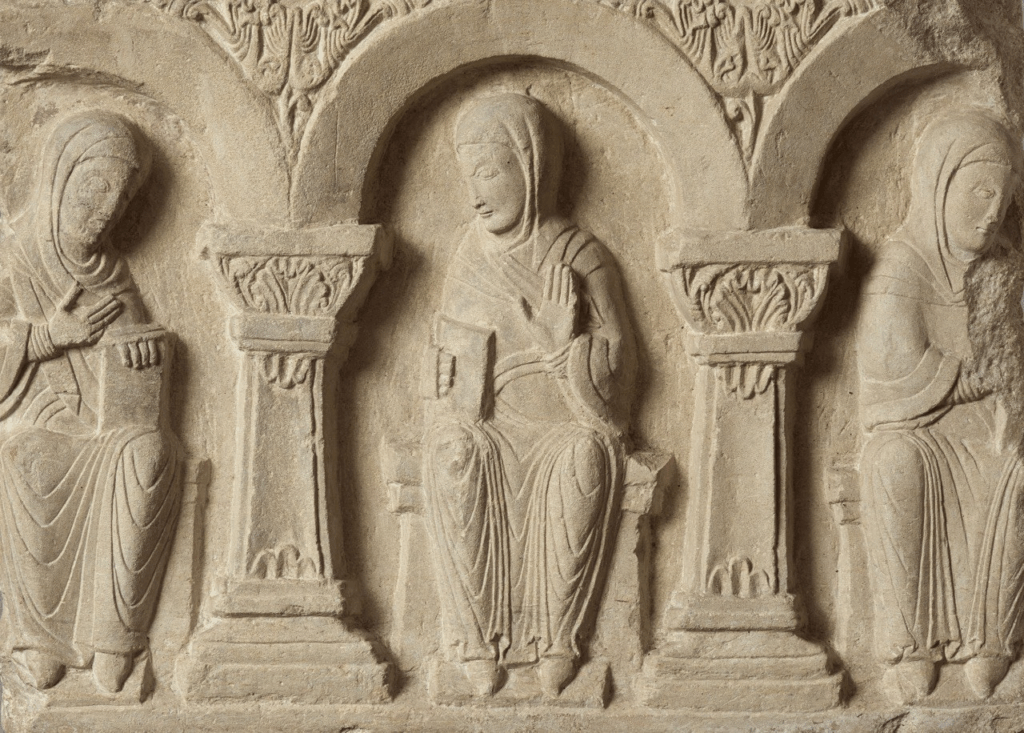The Materiality of the Medingen Manuscripts in the Bodleian Library
Blog post for the conference ‘ZwischenRäume. Geistliche Frauen des Mittelalters zwischen Memoria und Materialität‘, organised by Gisela Muschiol in Bonn 26–28 June 2025
Liminal Spaces: Religious Women in the Middle Ages between Memoria and Materiality
The major exhibition Krone und Schleier (“Crown and Veil”), held in Essen and Bonn in 2005, marked a significant milestone in the scholarly engagement with religious women of the Middle Ages. At the same time, both the exhibition and the accompanying academic conference stimulated new lines of inquiry. Twenty years on from Krone und Schleier, it is timely to take stock and reflect on the insights and developments that have emerged in the intervening decades.
From a historical perspective, the past forty years have witnessed remarkable shifts in the contextualisation of the lived realities of religious women and their communities, as well as a re-evaluation of the sources. The focus now turns to the liminal spaces inhabited by these women, between enclosure and the world, between external expectations and internal aspirations, and between constraints and agency.
An assessment of these liminal spaces reveals that medieval religious women shaped their convents as places of retreat which, at the same time, exerted influence on broader societal developments. These spaces could function simultaneously as sites of memoria and of authority, as arenas of relationship-building and identity formation.
ZwischenRäume. Geistliche Frauen des Mittelalters zwischen Memoria und Materialität
Mit der großen Ausstellung „Krone und Schleier“, die im Jahr 2005 in Essen und Bonn stattfand, wurde eine erste Bilanz der Forschung zu geistlichen Frauen des Mittelalters gezogen. Gleichzeitig regten die Ausstellung sowie der zugehörige wissenschaftliche Kongress die Forschung zu neuen Fragen an. 20 Jahre nach „Krone und Schleier“ ist es an der Zeit, Zwischenbilanzen zu ziehen und nach den Erkenntnissen und Entwicklungen der Forschung der vergangenen 20 Jahre zu fragen. Insgesamt gilt für die historische Perspektive auf die Lebenswirklichkeiten geistlicher Frauen und ihrer Gemeinschaften, dass die vergangenen 40 Jahre bemerkenswerte Veränderungen der historischen Kontextualisierung und eine neue Sicht auf die Quellen hervorgerufen haben. Im Fokus sollen die ZwischenRäume der geistlichen Frauen stehen, zwischen Klausur und Welt, zwischen äußeren und inneren Ansprüchen und Handlungsoptionen. Eine Bilanz der ZwischenRäume kann sichtbar machen, dass geistliche Frauen des Mittelalters in ihren Konventen einen Rückzugsraum gestalteten, der gleichzeitig Auswirkungen auf gesellschaftliche Entwicklungen hatte, der sowohl Raum der Memoria als auch Raum der Herrschaft, Raum der Beziehungen und Raum der Identitäten sein konnte.

Flyer Tagung ZwischenRäume: Download
Presentation recording
Prerecorded video of traces of material engagement with the liturgy in three Medingen manuscripts in the Bodleian Library, presented by Andrew Dunning, Curator of Medieval Manuscripts.
Manuscripts in order of appearance, for more information cf. https://medingen.seh.ox.ac.uk under the relevant sigla.
O2: Manual for the Provost (O2): Oxford, Bodleian Library, MS. Lat. liturg. e. 18 — early 1470s, revised c. 1479
– fol. 2: added half-page, glued in
– fol. 47vb: Cum rex gloriae with initial
– fol. 82: sewn-in additional prayer; updated old quire of the ‘Rituale’ for anointing the sick
O1: Medingen Bodleian Prayer-Book (O1): MS. Lat. liturg. f. 4 — third quarter 15th century, revised after 1494 and in the 16th century
– Binding with the roll stamp of Venus, Prudentia, and Lucretia
– fol. 28v (prayer for Lüneburg and the Abbess of Medingen)
– fol. 174v (nuns and lay-people greet the Easter sun)
– fol. 141v (Glued-in maiden)
– fol. 200v hook-shaped paper veil for S: Sewn in by making use of the perforation made by pricking
– fol. 217v (Glued-in lions)
O4: Medingen Bodleian Psalter (O4): Oxford, Bodleian Library, MS. Don. e. 248 — after 1505
– Binding, bone plaque and its 19th century frame
– fol. 14v-15r to show that the edges were trimmed
– fol. 16v-17r to show addition
– fol. 31v-32r to show that the additions were part of the rebinding
– fol. 113v: new initial to show psalter structure after the Reformation
– fol. 173r Harrowing of Hell, veil, Quis est iste
The actual presentation recorded in German (but without the video).
Photographs from the conference ‘Passion und Ostern in den Lüneburger Klöstern’, March 2009 in Ebstorf

